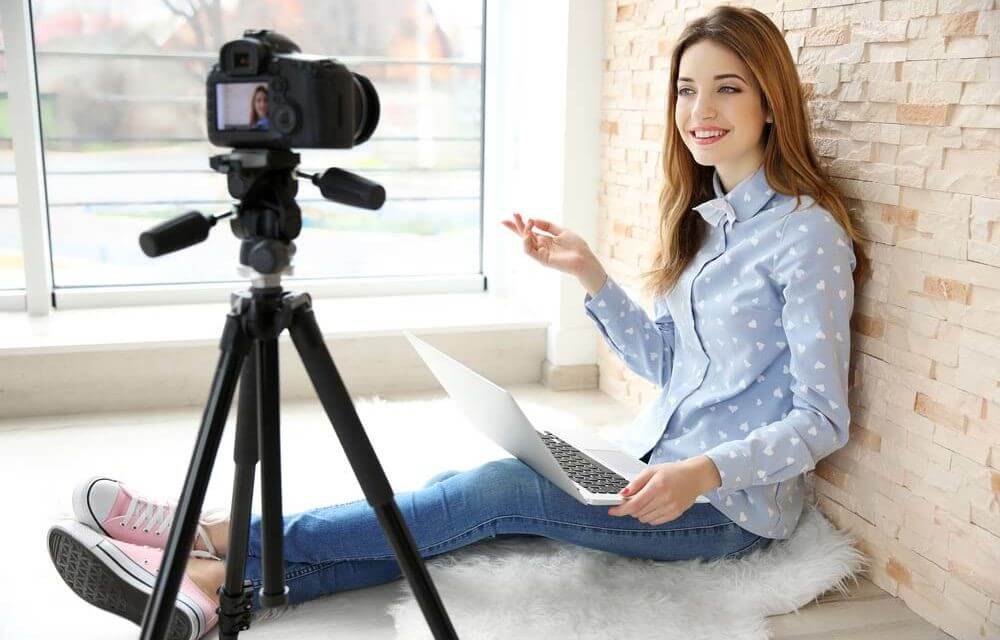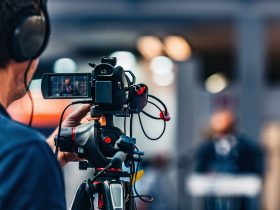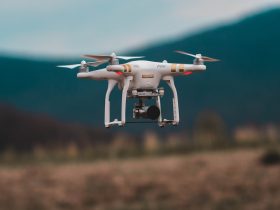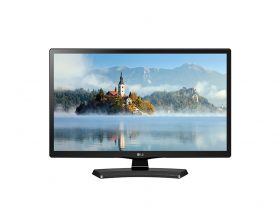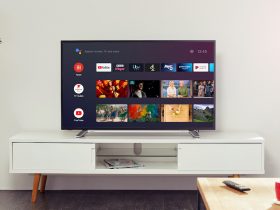Are you looking for a vlogging camera to produce high-quality videos? In this post, we are presenting our picks for the best vlogging cameras after spending more than 20 hours on testing and research.
What Are the Requirements for Vlogging Cameras?
Subject matter for vlogging can be anyone, including yourself, or anything. And it can be anywhere: in your studio, on the go, while traveling…etc. So that gives a variety of requirements for a vlogging camera.
It should be able to record high-quality videos in a variety of conditions; offer image stabilization and tilting screens so you can check framing when you film yourself. Plus, it should be lightweight to be able to handhold even while hooked to a portable tripod.
As you can see, part of the requirement is mobility. So your smartphone definitely has an advantage there. Plus, it’s no secret that today’s smartphone cameras are successfully competing with high-end DSLR and mirrorless cameras for image and video quality.
However, with lightweight models, tilt screens, and top-notch video resolutions, mirrorless, and DSLR cameras are still the go-to choice of professional vloggers. Plus, you can always whip up your smartphone from the pocket if the situation calls for it.
So in this guide, we are considering all these unique vlogging requirements to come up with the best choices in the market today. Here’s an overview of what we are recommending. Scroll down to see the reviews.
Top 10 Best Vlogging Cameras
Sony RX100 VI
[amazon box=”B07DKG29RG” template=”vertical”]
Type: Compact | Sensor: CMOS | Max video resolution: 4K UHD 2160p | LCD: Tilting 3-inch, 921,600 dots | Weight: 301g | Megapixels: 20.1 MP | Connectivity: Wi-Fi, HDMI D (Micro), USB 2.0 Micro-B | Size: 105.5 x 60.9 x 42mm
If you’re a vlogger who also needs a decent camera for your images, say thumbnail images, look no further than the Sony RX100 VI. Sony has been the leading name in video cameras for years. With a versatile zoom range of 24-200mm, plus the ability to shoot high-quality videos in 4k up to 25fps, you can’t go wrong with this model.
There are a few other features thrown in; such as the ability to take super-slow-motion videos, extremely fast autofocus, and AI-based real-time subject tracking. During our tests, we felt the built-in mic quality was OK but it would be better if it has an input slot for an external microphone. But with all the other great features, it is hard to overlook how great this camera is.
Canon Powershot G7 X Mark III
[amazon box=”B07VGP64G1″ template=”vertical”]
Type: Compact | Sensor: CMOS | Max video resolution: 4K 30p / FHD 120p | LCD: Tilting 3-inch, 1,040,000 Dot | Weight: 304g | Megapixels: 20.1 MP | Connectivity: Wi-Fi, AV Output, HDMI, USB 2.0, Bluetooth, USB 2.0 Micro | Size: 105 x 61 x 41 mm
As a vlogger you need to follow the action, but how can you do that if you’re weighed down by bulky camera kit? This is where the lightweight and feature-packed Canon PowerShot G7 X Mark III comes into its own.
It provides all the great features you’d find on a bigger camera and has compressed them down into a perfectly portable size.
The 3-inch touchscreen does not only tilt, but it flips too–making it easy to ensure you’re in the frame when you’re talking to the camera. With added 5-axis image stabilization, you won’t fall victim to camera shake if you have to quickly whip the camera out to capture an unfolding scene handheld.
With a built-in auto-leveling feature, you can rest easy knowing those beautiful sunsets you shoot for b-roll won’t end up lopsided. Plus, the 4K video resolution and external mic input upgrade over the mark II model ensures you’ll always record the highest quality videos.
Sony A6400
[amazon box=”B07MTWVN3M” template=”vertical”]
Type: Mirrorless | Sensor: CMOS APS-C | Max video resolution: UHD 4K 2160p | LCD: Tilting 3-inch, 921,600 dots | Weight: 667g | Megapixels: 25 MP | Connectivity: Wi-Fi, 3.5mm Microphone, HDMI D (Micro), Wired Remote Port, Micro-B (USB 2.0) | Size: 120 x 66.9 x 59.7mm
Another contender for the perfect beginner vlogging camera is the Sony A6400. It has all the features that will allow you to hit the ground running. The eye and face tracking is extremely accurate, so you won’t end up with video focussed on something in the background. Plus the 3-inch LCD screen flips up so you can see yourself when talking to the camera.
You have the flexibility of interchanging lenses and the video quality is extremely sharp thanks to 4k video shooting capabilities. The microphone jack allows you to connect your own external microphone for more professional sound quality. The Sony A6400 is a great choice for a vlogging camera and will have you well on your way to becoming an internet sensation in no time.
Panasonic Lumix G85
[amazon box=”B01M050N05″ template=”vertical”]
Type: Mirrorless | Sensor: MOS | Max video resolution: UHD 4K 2160p | LCD: 3-inch, 1,040,000 Dot | Weight: 503g | Megapixels: 16 MP | Connectivity: Wi-Fi, 3.5mm Microphone, 2.5mm Sub-Mini, HDMI D (Micro), Micro-B (USB 2.0) | Size: 128 x 89 x 74mm
The Panasonic Lumix G85 boasts some great features that make it a really great vlogging camera. The amazing, fast autofocus does not move around when you’re trying to film one subject. Plus the image quality is crisp and thanks to the lack of an optical low-pass filter, your videos will look beautiful and sharp.
There is also the option to set a specific video frame as a photo–very handy if you need a thumbnail shot for your video home page.
The camera comes equipped with a ‘smart selfie’ mode, as well as ‘beautifying functions’ if you’re feeling less than glamorous. If you’re looking for the perfect vlogging camera on a budget you don’t have to look any further.
Fujifilm X-A5
[amazon box=”B079BVQMND” template=”vertical”]
Type: Mirrorless | Sensor: CMOS APS-C | Max video resolution: UHD 4K 2160p | LCD: Tilting 3-inch, 1,040,000 dots | Weight: 785g | Megapixels: 24.2 MP | Connectivity: Wi-Fi, Bluetooth, 2.5mm Sub-Mini, HDMI D (Micro), Micro-B (USB 2.0) | Size: 117 x 68 x 40 mm
The Fujifilm X-A5 is a compact camera, easy to pop in your backpack and take with you on vlogging adventures. It’s easy to use with built-in features that will make your vlogging experience fun. You can flip the LCD screen a full 180 degrees, enabling you to film yourself talking to the camera with ease. Plus when the screen is flipped, it automatically enables eye-detection autofocus.
The LCD screen is a touchscreen, which you can use to focus on different subjects, rather than having to use dials to adjust the focus point.
Even when it’s fitted with the 15-45mm lens it remains extremely slim and compact. The addition of a retractable lens gives the camera power zoom capabilities, which can be great when you’re trying to add more drama to your shots.
Nikon D5600
[amazon box=”B01N7OJNEX” template=”vertical”]
Type: DSLR | Sensor: CMOS APS-C | Max video resolution: 1080p | LCD: Tilting and rotating 3.2-inch, 1,037,000 dots | Weight: 544g | Megapixels: 24.2 MP | Connectivity: Wi-Fi, Bluetooth, HDMI C (Mini), Micro-B (USB 2.0) | Size: 124 x 97 x 70mm
If a compact point and shoot isn’t your cup of tea, or if you’re looking for a vlogging experience with more control over your camera settings, look no further than the Nikon D5600. Although a DSLR camera, it’s still portable thanks to its small size, and when the retractable 18-55mm VR lens is added, the sky is the limit.
The lens is great for shooting video, with focus transitions that are extremely smooth; you won’t have to edit out the whirring sound every time your camera focuses.
The 3.2-inch LCD screen is able to fully articulate, which helps you frame when filming yourself. The maximum video resolution is 1080p, which is more than enough for daily vlogging. Plus, due to its large crop sensor, the D5600 performs better than most mirrorless or compact cameras in low light conditions, useful if you are shooting indoors without studio lights.
DJI Osmo Pocket
[amazon box=”B07KVV1W5S” template=”vertical”]
Type: Steadicam video camera | Sensor: 1-Chip 2/3″ | Max video resolution: UHD 4K 2160p | LCD: 1.08 inches | Weight: 119g | Megapixels: 12 MP | Connectivity: Wi-Fi (with module), USB 2.0 Type-C | Size: 121.9 x 36.9 x 28.6 mm
Are you a vlogger who is always on the go? You can easily fit the DJI Osmo Pocket video camera into your pocket, which may make it the best vlogging camera for you.
An extremely portable, affordable vlogging camera that can record 4K video at 60fps, or full HD video at up to 120fps. What is lacks in size, it makes up for on quality. The integrated gimbal ensures great image stabilization. You can use the camera on its own or it can be plugged into your smartphone and controlled through an app.
There are also plenty of DJI accessories available to enhance your vlogging experience. This is an amazing little machine– Casey Neistat agrees!
Olympus Pen E-PL9
[amazon box=”B07B7FT7BN” template=”vertical”]
Type: Mirrorless | Sensor: MOS | Max video resolution: UHD 4K 2160p | LCD: Tilting 3-inch, 1,040,000 dots | Weight: 380g | Megapixels: 16.1 MP | Connectivity: Wi-Fi, Bluetooth, HDMI D (Micro), Micro-B (USB 2.0) | Size: 117 x 68 x 39 mm
If you’re after a stylish camera that is also versatile, the Olympus Pen E-PL9 boasts simple features, compressed into an easy-to-use package. The 14-42mm pancake kit lens features a quiet, motorized zoom that is great for vlogging.
The mirrorless E-PL9 features a 3-inch articulated LCD touchscreen, plus combined facial and eye detection, allowing you to view yourself and stay in focus when you’re vlogging in selfie mode.
You can shoot your vlogs on 4K at 40fps, or 720p at 120fps, depending on your needs. The 3-axis image stabilization enables you to shoot video and images without a camera shake. Plus, we really like the uncomplicated menus and the helpful pro-level shooting mode selections.
Do you need help with all the control that a mirrorless camera provides you with? E-PL9’s shooting mode selector can be the answer.
Olympus Tough TG-Tracker
[amazon box=”B01ERLMQ6S” template=”vertical”]
Type: Action Camera | Sensor: 1-Chip CMOS | Max video resolution: UHD 4K 2160p | LCD: 1.15-inch, 115,200 dots | Weight: 181g | Megapixels: 8 MP | Connectivity: Wi-Fi | Size: 35.0 x 56.5 x 93.2 mm
If your vlogging involves hiking, doing motorbike stunts in your backyard, or anything underwater, the Olympus Tough TG-Tracker is the dream camera for you.
This little beast comes in a fully loaded, compact package. It is waterproof up to a depth of 30m, freeze-proof up to -10 degrees, and crush-proof as it can hold up to 100kgs and can survive a 2.1m drop. If you’re looking for a camera you can throw around and forget about, you’ve come to the right place.
Although the LCD screen is small, the video resolution is superb. With 4K ultra-high-definition video and an integrated fisheye lens, no detail will go unrecorded.
If your vlogging adventures take you to the great outdoors, this camera includes 3-axis image stabilization, a compass, a thermometer, and a headlight if it becomes too dark.
The built-in ultra-wide lens also has a fixed focus, so you won’t have to worry about the camera focusing on the wrong thing during a stunt.
Canon EOS M50
[amazon box=”B079Y45KTJ” template=”vertical”]
Type: Mirrorless | Sensor: CMOS APS-C | Max video resolution: UHD 4K 2160p | LCD: Tilting 3-inch, 1,040,000 dots | Weight: 387g | Megapixels: 25.8 MP | Connectivity: Wi-Fi, Bluetooth, 3.5mm Microphone, HDMI D (Micro), Micro-B (USB 2.0) | Size: 116.3 x 88.1 x 58.7 mm
The Canon EOS M50 has everything a budding vlogger could need.
It’s portable; you can carry it everywhere so you’ll never miss a vloggable moment. It includes 4K video capabilities and a screen that can be turned to face you when you film yourself.
There’s an integrated microphone port, so you don’t have to rely on the basic camera microphone. The touchscreen is easy to use with basic settings laid out in front of you, making switching between them an absolute breeze.
How to Choose the Best Vlogging Camera?
So what are the most important features to take into account when buying a vlogging camera?
We will show you the specific features famous YouTubers look for in a camera to produce their most popular videos.
There are 7 main points to take into consideration when deciding which camera is best for your vlogging needs:
- Video resolution;
- Ergonomics;
- Sound quality and microphone port;
- Low light performance;
- Image stabilization;
- Autofocus; and
- LCD screen flexibility.
Let’s take a look at the top characteristics to keep in mind while shopping for a new camera.
Which Video Resolution Is Best?
When we talk about resolution, we refer to the quality of the video recording. If you only plan to publish videos online, you don’t need to record in full 4K; 1080p resolution is more than enough.
Many cameras offer 4K as standard, so you may find not much price difference between that and 1080p. However, bear in mind that if you shoot in 4K you’ll need a powerful computer to handle large files. 1080p is more manageable at the editing stage, especially if you intend to record a high number of short videos. If huge file sizes are a problem, you can use a handbrake, ffmpeg, or a free online video compressor to lower the resolution or bitrate of the video.
Think about Ergonomics
Ergonomics, weight, and portability all make a difference if you travel to create your vlogs or you create action videos. However, if you shoot at home, you’ll probably set the camera up on a tripod.
Making sure that your camera has a comfortable grip and feels stable when it is handheld is essential. Viewers will notice if you struggle to hold it straight or if you can’t reach the control buttons easily.
The best video camera should be lightweight and compact, balancing image quality with portability.
Sound Quality Should Shine
Sound quality is an important factor you need to take into account.
If you use the camera’s internal microphone, you may encounter problems with background noise, wind, and other unwanted sounds.
If there is a microphone jack, you can attach an external microphone to the camera body via the hot shoe; this will allow you to capture more professional sound.
Do You Film in Low Light?
If you vlog from home, your available light may not always be the best. Unless you plan to buy a full set of studio lights, you will need a camera that performs well in low light.
DSLRs tend to be slightly better in this respect than compact or mirrorless cameras, however, performance in darker environments depends largely on the type of lens available.
If you opt for a camera with interchangeable lenses, you will be able to switch your glass to something that lets more light in than usual.
If you shoot outdoors with more light available, fixed lenses may be your best bet.
Image Stabilization Is Important
A camera that includes an image stabilization system is highly recommended for vloggers. While some cameras have this built-in, others will have the option of using lenses with vibration reduction technology.
Creating a stabilized image when you maneuver the camera by hand will make a huge difference to your final video. This is one of the most important elements to consider, especially if you don’t use a DSLR tripod.
Autofocus Is a Key Consideration
Most cameras have a decent autofocus system when it comes to video, but some are better than others.
The best option is to choose a camera with a facial recognition feature. An even better option is if it has an integrated facial tracking system that follows faces as they move.
The autofocus system must also be quick; there is nothing more annoying than watching a video of a blurred subject. The camera and lens must work at high speeds to ensure the focus point follows the subject automatically and smoothly.
LCD Screen Flexibility
One of the most essential features to take into account is the screen; it should tilt enough so you can see the screen if you talk to the camera.
One important thing to remember, however, is to look into the camera lens rather than the screen when talking to the camera.
You may not need a fully tilting screen if you use a wide-angle lens or you attach an external monitor to the camera. The easiest way to do the latter is via a Wi-Fi system that allows you to see what you are shooting through your smartphone. Action cameras usually provide this feature, however, it is not common in mirrorless or DSLR cameras.
It’s Time to Get Creative
Choosing a great camera is just the first step toward creating a successful vlog. While modern cameras allow you to shoot high-quality films without breaking the bank, editing, lighting, and good scriptwriting all play a part in the production of a good video.
Many vloggers have gathered a massive following. Although succeeding is far from easy, there is unlimited potential in what you can do today thanks to new technology, media outlets, and publishing platforms. Your creativity is the only limit!
We hope we’ve shown you some useful options when it comes to the best vlogging camera. By saving time with your choice now, you’ll be able to focus more on your vlog message and how to present it.
Do bear in mind that technology changes fast and the best cameras of today may not be the same as those available next year. Make sure you come back and check for updates; we’ll be revising this guide as new gear hits the market.

